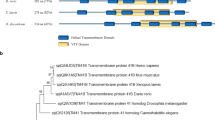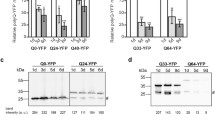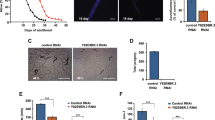Abstract
Small ubiquitin-related modifiers (SUMOs) are important regulator proteins. Caenorhabditis elegans contains a single SUMO ortholog, SMO-1, necessary for the reproduction of C. elegans. In this study, we constructed transgenic C. elegans strains expressing human SUMO-1 under the control of pan-neuronal (aex-3) or pan-muscular (myo-4) promoter and SUMO-2 under the control of myo-4 promoter. Interestingly, muscular overexpression of SUMO-1 or -2 resulted in morphological changes of the posterior part of the nematode. Movement, reproduction and aging of C. elegans were perturbed by the overexpression of SUMO-1 or -2. Genome-wide expression analyses revealed that several genes encoding components of SUMOylation pathway and ubiquitin-proteasome system were upregulated in SUMO-overexpressing nematodes. Since muscular overexpression of SMO-1 also brought up reproductive and mobility perturbations, our results imply that the phenotypes were largely due to an excess of SUMO, suggesting that a tight control of SUMO levels is important for the normal development of multicellular organisms.





Similar content being viewed by others
Abbreviations
- SUMO:
-
Small ubiquitin-like modifier
- SMO:
-
Caenorhabditis elegans SUMO
- UBC9:
-
SUMO E2 conjugase
- H2Bub1:
-
Monoubiquitylated histone 2B
References
Bossis G, Melchior F (2006) SUMO: regulating the regulator. Cell Div 1:13
Geiss-Friedlander R, Melchior F (2007) Concepts in sumoylation: a decade on. Nat Rev Mol Cell Biol 8:947–956
Bohren KM, Nadkarni V, Song JH, Gabbay KH, Owerbach D (2004) A M55V polymorphism in a novel SUMO gene (SUMO-4) differentially activates heat shock transcription factors and is associated with susceptibility to type I diabetes mellitus. J Biol Chem 279:27233–27238
Owerbach D, McKay EM, Yeh ET, Gabbay KH, Bohren KM (2005) A proline-90 residue unique to SUMO-4 prevents maturation and sumoylation. Biochem Biophys Res Commun 337:517–520
Tatham MH, Jaffray E, Vaughan OA, Desterro JM, Botting CH, Naismith JH, Hay RT (2001) Polymeric chains of SUMO-2 and SUMO-3 are conjugated to protein substrates by SAE1/SAE2 and Ubc9. J Biol Chem 276:35368–35374
Sun H, Leverson JD, Hunter T (2007) Conserved function of RNF4 family proteins in eukaryotes: targeting a ubiquitin ligase to SUMOylated proteins. EMBO J 26:4102–4112
Tatham MH, Geoffroy MC, Shen L, Plechanovova A, Hattersley N, Jaffray EG, Palvimo JJ, Hay RT (2008) RNF4 is a poly-SUMO-specific E3 ubiquitin ligase required for arsenic-induced PML degradation. Nat Cell Biol 10:538–546
Prudden J, Pebernard S, Raffa G, Slavin DA, Perry JJ, Tainer JA, McGowan CH, Boddy MN (2007) SUMO-targeted ubiquitin ligases in genome stability. EMBO J 26:4089–4101
Kerscher O (2007) SUMO junction—what’s your function? New insights through SUMO-interacting motifs. EMBO Rep 8:550–555
Rytinki MM, Kaikkonen S, Pehkonen P, Jaaskelainen T, Palvimo JJ (2009) PIAS proteins: pleiotropic interactors associated with SUMO. Cell Mol Life Sci 66:3029–3041
Hay RT (2007) SUMO-specific proteases: a twist in the tail. Trends Cell Biol 17:370–376
Yeh ET (2009) SUMOylation and De-SUMOylation: wrestling with life’s processes. J Biol Chem 284:8223–8227
Heun P (2007) SUMOrganization of the nucleus. Curr Opin Cell Biol 19:350–355
Kaminsky R, Denison C, Bening-Abu-Shach U, Chisholm AD, Gygi SP, Broday L (2009) SUMO regulates the assembly and function of a cytoplasmic intermediate filament protein in C. elegans. Dev Cell 17:724–735
Zhang H, Smolen GA, Palmer R, Christoforou A, van den Heuvel S, Haber DA (2004) SUMO modification is required for in vivo Hox gene regulation by the Caenorhabditis elegans Polycomb group protein SOP-2. Nat Genet 36:507–511
Poulin G, Dong Y, Fraser AG, Hopper NA, Ahringer J (2005) Chromatin regulation and sumoylation in the inhibition of Ras-induced vulval development in Caenorhabditis elegans. EMBO J 24:2613–2623
Kim SH, Michael WM (2008) Regulated proteolysis of DNA polymerase eta during the DNA-damage response in C. elegans. Mol Cell 32:757–766
Holway AH, Hung C, Michael WM (2005) Systematic, RNA-interference-mediated identification of mus-101 modifier genes in Caenorhabditis elegans. Genetics 169:1451–1460
Broday L, Kolotuev I, Didier C, Bhoumik A, Gupta BP, Sternberg PW, Podbilewicz B, Ronai Z (2004) The small ubiquitin-like modifier (SUMO) is required for gonadal and uterine–vulval morphogenesis in Caenorhabditis elegans. Genes Dev 18:2380–2391
Roy Chowdhuri S, Aslam S, Okkema PG, Crum T, Woollard A (2006) The T-box factor TBX-2 and the SUMO conjugating enzyme UBC-9 are required for ABa-derived pharyngeal muscle in C. elegans. Dev Biol 295:664–677
Talamillo A, Sanchez J, Cantera R, Perez C, Martin D, Caminero E, Barrio R (2008) Smt3 is required for Drosophila melanogaster metamorphosis. Development 135:1659–1668
Nacerddine K, Lehembre F, Bhaumik M, Artus J, Cohen-Tannoudji M, Babinet C, Pandolfi PP, Dejean A (2005) The SUMO pathway is essential for nuclear integrity and chromosome segregation in mice. Dev Cell 9:769–779
Zhang FP, Mikkonen L, Toppari J, Palvimo JJ, Thesleff I, Janne OA (2008) Sumo-1 function is dispensable in normal mouse development. Mol Cell Biol 28:5381–5390
Yuan H, Zhou J, Deng M, Liu X, Le Bras M, de The H, Chen SJ, Chen Z, Liu TX, Zhu J (2010) Small ubiquitin-related modifier paralogs are indispensable but functionally redundant during early development of zebrafish. Cell Res 20:185–196
Nowak M, Hammerschmidt M (2006) Ubc9 regulates mitosis and cell survival during zebrafish development. Mol Biol Cell 17:5324–5336
Vartiainen S, Aarnio V, Lakso M, Wong G (2006) Increased lifespan in transgenic Caenorhabditis elegans overexpressing human alpha-synuclein. Exp Gerontol 41:871–876
Kamitani T, Nguyen HP, Yeh ET (1997) Preferential modification of nuclear proteins by a novel ubiquitin-like molecule. J Biol Chem 272:14001–14004
Dupuy D, Li QR, Deplancke B, Boxem M, Hao T, Lamesch P, Sequerra R, Bosak S, Doucette-Stamm L, Hope IA, Hill DE, Walhout AJ, Vidal M (2004) A first version of the Caenorhabditis elegans Promoterome. Genome Res 14:2169–2175
Vartiainen S, Pehkonen P, Lakso M, Nass R, Wong G (2006) Identification of gene expression changes in transgenic C. elegans overexpressing human alpha-synuclein. Neurobiol Dis 22:477–486
Rytinki MM, Palvimo JJ (2009) SUMOylation attenuates the function of PGC-1 alpha. J Biol Chem 284:26184–26193
Karvonen U, Kallio PJ, Janne OA, Palvimo JJ (1997) Interaction of androgen receptors with androgen response element in intact cells. Roles of amino- and carboxyl-terminal regions and the ligand. J Biol Chem 272:15973–15979
R Development Core Team (2009) R: a language and environment for statistical computing. R Foundation for Statistical Computing, Austria
Gentleman RC, Carey VJ, Bates DM, Bolstad B, Dettling M, Dudoit S, Ellis B, Gautier L, Ge Y, Gentry J, Hornik K, Hothorn T, Huber W, Iacus S, Irizarry R, Leisch F, Li C, Maechler M, Rossini AJ, Sawitzki G, Smith C, Smyth G, Tierney L, Yang JY, Zhang J (2004) Bioconductor: open software development for computational biology and bioinformatics. Genome Biol 5:R80
Irizarry RA, Hobbs B, Collin F, Beazer-Barclay YD, Antonellis KJ, Scherf U, Speed TP (2003) Exploration, normalization, and summaries of high density oligonucleotide array probe level data. Biostatistics 4:249–264
Smyth GK (2004) Linear models and empirical bayes methods for assessing differential expression in microarray experiments. Stat Appl Genet Mol Biol 3:Article 3
Benjamini Y, Hochberg Y (1995) Controlling the false discovery rate: a practical and powerful approach to multiple testing. J R Stat Soc Ser B 57:289–300
Dennis G Jr, Sherman BT, Hosack DA, Yang J, Gao W, Lane HC, Lempicki RA (2003) DAVID: database for annotation, visualization, and integrated discovery. Genome Biol 4:P3
Huang da W, Sherman BT, Lempicki RA (2009) Systematic and integrative analysis of large gene lists using DAVID bioinformatics resources. Nat Protoc 4:44–57
Ashburner M, Ball CA, Blake JA, Botstein D, Butler H, Cherry JM, Davis AP, Dolinski K, Dwight SS, Eppig JT, Harris MA, Hill DP, Issel-Tarver L, Kasarskis A, Lewis S, Matese JC, Richardson JE, Ringwald M, Rubin GM, Sherlock G (2000) Gene ontology: tool for the unification of biology. The Gene Ontology Consortium. Nat Genet 25:25–29
Livak KJ, Schmittgen TD (2001) Analysis of relative gene expression data using real-time quantitative PCR and the 2[−Delta Delta C(T)] method. Methods 25:402–408
Bayer P, Arndt A, Metzger S, Mahajan R, Melchior F, Jaenicke R, Becker J (1998) Structure determination of the small ubiquitin-related modifier SUMO-1. J Mol Biol 280:275–286
Huang WC, Ko TP, Li SS, Wang AH (2004) Crystal structures of the human SUMO-2 protein at 1.6 Å and 1.2 Å resolution: implication on the functional differences of SUMO proteins. Eur J Biochem 271:4114–4122
Schrödinger (2009) Maestro v.2.1. Schrödinger, New York
Rocchia W, Alexov E, Honig B (2001) Extending the applicability of the nonlinear poisson–boltzmann equation: multiple dielectric constants and multivalent ions. J Phys Chem B 105:6507–6514
DeLano WL (2002) The PyMOL Molecular Graphics System. DeLano Scientific, San Carlos, CA
Hirsch C, Gauss R, Sommer T (2006) Coping with stress: cellular relaxation techniques. Trends Cell Biol 16:657–663
Stringham EG, Dixon DK, Jones D, Candido EP (1992) Temporal and spatial expression patterns of the small heat shock (hsp16) genes in transgenic Caenorhabditis elegans. Mol Biol Cell 3:221–233
Link CD, Cypser JR, Johnson CJ, Johnson TE (1999) Direct observation of stress response in Caenorhabditis elegans using a reporter transgene. Cell Stress Chaperones 4:235–242
Mitra A, Shevde LA, Samant RS (2009) Multi-faceted role of HSP40 in cancer. Clin Exp Metastasis 26:559–567
Yokoyama K, Fukumoto K, Murakami T, Harada S, Hosono R, Wadhwa R, Mitsui Y, Ohkuma S (2002) Extended longevity of Caenorhabditis elegans by knocking in extra copies of hsp70F, a homolog of mot-2 (mortalin)/mthsp70/Grp75. FEBS Lett 516:53–57
Hwang WW, Venkatasubrahmanyam S, Ianculescu AG, Tong A, Boone C, Madhani HD (2003) A conserved RING finger protein required for histone H2B monoubiquitination and cell size control. Mol Cell 11:261–266
Wood A, Krogan NJ, Dover J, Schneider J, Heidt J, Boateng MA, Dean K, Golshani A, Zhang Y, Greenblatt JF, Johnston M, Shilatifard A (2003) Bre1, an E3 ubiquitin ligase required for recruitment and substrate selection of Rad6 at a promoter. Mol Cell 11:267–274
Zhu B, Zheng Y, Pham AD, Mandal SS, Erdjument-Bromage H, Tempst P, Reinberg D (2005) Monoubiquitination of human histone H2B: the factors involved and their roles in HOX gene regulation. Mol Cell 20:601–611
Kim J, Hake SB, Roeder RG (2005) The human homolog of yeast BRE1 functions as a transcriptional coactivator through direct activator interactions. Mol Cell 20:759–770
Mimnaugh EG, Chen HY, Davie JR, Celis JE, Neckers L (1997) Rapid deubiquitination of nucleosomal histones in human tumor cells caused by proteasome inhibitors and stress response inducers: effects on replication, transcription, translation, and the cellular stress response. Biochemistry 36:14418–14429
Riquelme C, Barthel KK, Qin XF, Liu X (2006) Ubc9 expression is essential for myotube formation in C2C12. Exp Cell Res 312:2132–2141
Saitoh H, Hinchey J (2000) Functional heterogeneity of small ubiquitin-related protein modifiers SUMO-1 versus SUMO-2/3. J Biol Chem 275:6252–6258
Golebiowski F, Matic I, Tatham MH, Cole C, Yin Y, Nakamura A, Cox J, Barton GJ, Mann M, Hay RT (2009) System-wide changes to SUMO modifications in response to heat shock. Sci Signal 2:ra24
Minsky N, Shema E, Field Y, Schuster M, Segal E, Oren M (2008) Monoubiquitinated H2B is associated with the transcribed region of highly expressed genes in human cells. Nat Cell Biol 10:483–488
Weake VM, Workman JL (2008) Histone ubiquitination: triggering gene activity. Mol Cell 29:653–663
Jones D, Crowe E, Stevens TA, Candido EP (2002) Functional and phylogenetic analysis of the ubiquitylation system in Caenorhabditis elegans: ubiquitin-conjugating enzymes, ubiquitin-activating enzymes, and ubiquitin-like proteins Genome Biol 3: RESEARCH0002
Song J, Zhang Z, Hu W, Chen Y (2005) Small ubiquitin-like modifier (SUMO) recognition of a SUMO binding motif: a reversal of the bound orientation. J Biol Chem 280:40122–40129
Song J, Durrin LK, Wilkinson TA, Krontiris TG, Chen Y (2004) Identification of a SUMO-binding motif that recognizes SUMO-modified proteins. Proc Natl Acad Sci USA 101:14373–14378
Acknowledgments
We are grateful for the microscopy expertise of Dr. Simon Tuck. We thank the members of the NordForsk Nordic C. elegans Research Network for helpful discussions and reagents. This work was supported by The Academy of Finland, Finnish Cancer Organisations, Sigrid Jusélius Foundation, Saastamoinen Foundation, Biocenter Finland and Kuopio Graduate School of Molecular Medicine.
Author information
Authors and Affiliations
Corresponding author
Rights and permissions
About this article
Cite this article
Rytinki, M.M., Lakso, M., Pehkonen, P. et al. Overexpression of SUMO perturbs the growth and development of Caenorhabditis elegans . Cell. Mol. Life Sci. 68, 3219–3232 (2011). https://doi.org/10.1007/s00018-011-0627-4
Received:
Revised:
Accepted:
Published:
Issue Date:
DOI: https://doi.org/10.1007/s00018-011-0627-4




